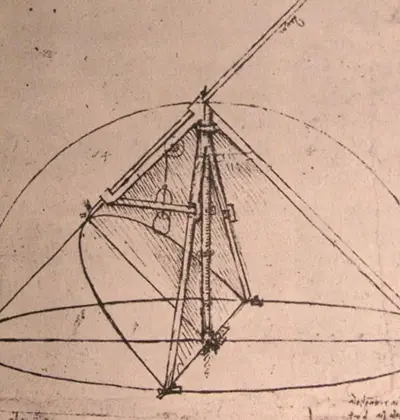The signature of the artist is on the lower right-hand corner of the drawing. The sketch itself is a thing of beauty, a harmony of straight lines, angles and curves.
One feature of the drawing is the various planes of hatching and shading that give the sketch a sense of motion.
Another feature is the way that the parabola seems to lift off of its own image on the paper, a demonstration of the versatility of the instrument and a humorous quirk in the drawing. Why did Leonardo design a parabolic compass?
The early Renaissance was in progress and everywhere, engineers and architects were excavating ancient ruins and erecting buildings in the classical style, with porticoes and columns, triangular pediments and lengthy friezes.
As Leonardo absorbed the beauty of this world, he developed an awareness of geometry in town planning, building design and surface decoration - and in painting.
Artists were using the discipline of geometry to create perspective, that is, the illusion of a 3-D world on two-dimensional surfaces.
This effect can be seen in the paintings of Andrea Mantegna and Paolo Uccello. Later in his life, Leonardo would paint The Last Supper, where the space behind Our Lord and his disciples recedes into the background.
In the meantime, Leonardo developed the instincts and skills of an engineer. One limitation of Renaissance engineering was that while builders could make the perfect circle with a rope and a pair of poles, with one staked in the ground, nothing existed for rendering the many subtle variations of the parabola.
Since classical times, artists and mathematicians had been able to render irreducible shapes like the square and the circle quite accurately. Leonardo advanced the discipline by using his engineering mind in designing the parabolic compass.
The majority of people regard Leonardo as a painter but he spent much of his life in the service of Italian nobles, working as a military engineer.
Interestingly, Leonardo lived two centuries in advance of the progress in integral calculus, the branch of mathematics that enabled 17th-century architects to plot curves accurately, creating their extravagant Baroque buildings.
How Leonardo actually drew the Design for a Parabolic Compass without access to his own, uninvented mathematical instrument will remain, like so much else about the artist, a mystery.


